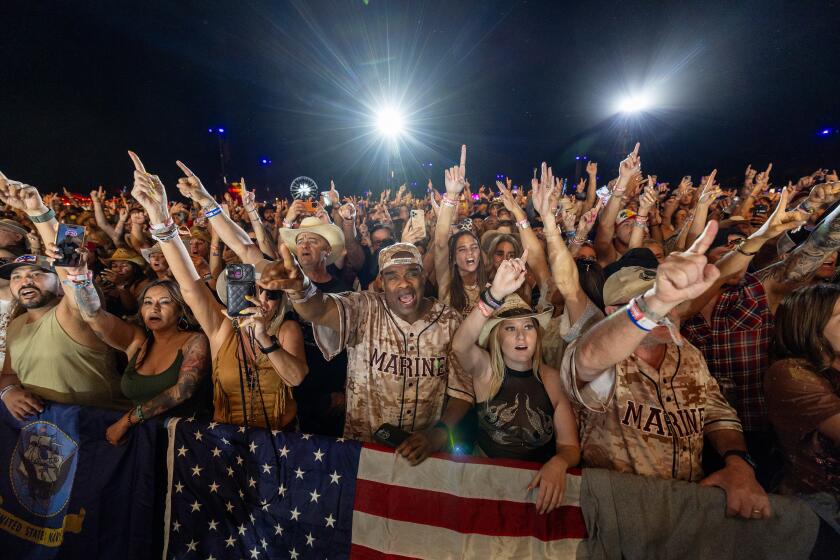Lucha VaVoom and Cirque Berzerk are L.A.’s theater of the odd
Don’t be fooled by her riding crop, her past career as a porn-film costumer or her penchant for punk rock and Russ Meyer flicks. Take all that away, and Rita D’Albert is a nice Jewish girl from Flushing, Queens, who adores Gilbert and Sullivan operettas and Carnaby Street fashion and gets mushy over Broadway show tunes.
An actor, dancer and former guitarist with the all-female rock band the Pandoras, D’Albert turned to making alternative theater a decade ago, convinced that Angeleno audiences craved something with a bit more glitz and bite than the traditional “well-made” play.
FOR THE RECORD:
Band manager: An article last Sunday about L.A. alternative theater said Lucha VaVoom producer Rita D’Albert once managed a Dutch rock band called Gore. She previously managed the American group GWAR. —
“When Bush was in, you didn’t need to be a genius to see we were going to need shows like Busby Berkeley to get us through our new depression,” she said over lunch at a Silver Lake vegan restaurant.
Today, D’Albert and her producing partner Liz Fairbairn are the brains behind Lucha VaVoom, the aggressively outré mash-up of Mexican lucha libre wrestling, burlesque striptease and post-punk vaudeville that recently packed in a motley, spirited crowd at downtown’s Art Deco-style Mayan Theatre. Now in its seventh year, Lucha VaVoom produces new shows annually and is one of a modest but increasing number of hard-to-classify homegrown L.A. entertainments that are stretching the boundaries of live performance. In doing so, these shows are attracting audiences whose theatrical tastes are as likely to have been shaped by B-movies, comic books and music videos as by “Hello, Dolly!” or the collected works of Arthur Miller.
“Audiences are so self-conscious here. They’re more concerned about who’s looking at them than about what they’re watching,” said Fairbairn, a college art major who spent nearly a decade managing the Dutch rock band Gore. “But it’s amazing about Lucha VaVoom. People walk in the doors and they just drop all that crap.”
A similarly posture-free party atmosphere pervades Cirque Berzerk’s “Beneath,” a Weimar cabaret-inspired, Goth-rock big top production that recently reextended its run under a 1,700-capacity circus tent in the Los Angeles State Historic Park (“The Cornfield”) on the edge of Chinatown.
Originally conceived in a stripped-down form in 2004 for the Burning Man gatheringGilbert and Sullivan in the Nevada desert, “Beneath” was forged by the artistic director tag team of producer/co-creator Suzanne Bernel; her husband, composer/co-creator Kevin Bourque; and choreographer Neal Everett.
“At Burning Man, if you’re doing anything that seems crazy you’re going to get good feedback,” Bourque, 42, an Emmy-nominated film editor, said while a makeup artist transformed his face into the ghoulish mask of the show’s Stygian ringmaster.
Occupying an intersection of performance art, rock music, circus, burlesque, physical theater and extreme sports, Lucha and Cirque are shotgun weddings of old-school razzle-dazzle, avant-garde experimentation and neo-retro versions of genres once regarded as too marginal or disreputable to enter the mainstream.
The prevailing aesthetic calls for a certain number of rough edges and a do-it-yourselfer enthusiasm. Although neither show really crosses the line from PG-13 into R territory, the occasional raunchiness is more couples-friendly than family-friendly.
Yet both shows present themselves as sleaze-free zones, where the emphasis is on the stylized sublimation of erotica. “To me the idea of doing nudity is a little cheap,” Bourque said. “We all know it’s sexier to see a girl in lingerie than naked.”
Judging by two recent performances, both Lucha and Cirque are drawing crowds that mirror the diversity of contemporary Los Angeles. Both shows’ audiences are amalgams of female and male, gay and straight, young and middle age, upwardly mobile and aspirational, Asian, Latino, African American and white.
An evening at Lucha VaVoom loosely centers on four or five bouts in which masked, flamboyantly costumed Mexican wrestlers with names like (the foul-minded) Dirty Sanchez and (the ultra-buff) El Presidente square off against each other in sweaty, mock-epic battles. The combatants divide into Técnicos (good guys) and Rudos (bad guys), enacting cartoon morality plays that both satirize and celebrate Mexican politics and pop culture.
But that’s only the main course. Lucha VaVoom’s in-between appetizers typically include aerial acts, “mini” wrestlers (be careful not to call them midgets) and pneumatically gifted burlesque artists (most, but not entirely, female) parading to pop tunes that go with the mix-and-match motifs (the Ohio Players’ “Fire” with firefighters, for instance). “Putting the girls in is kind of like ginger to your sushi,” D’Albert said. Casts are drawn from professional Lucha Libre wrestlers, some famous (such as Blue Demon Jr. and El Hijo del Santo), as well as professional striptease artists.
Audience participation also is encouraged, up to a point, especially if a masked luchador happens to come flying out of the ring and onto your lap. “Pacing has a lot to do with it,” Fairbairn said. “We just throw one crazy thing up in front of them, and then before they have a chance to assimilate it, on to the next thing.”
That describes both Lucha VaVoom, which will tour Chicago and New York this year, and its sister production, the “Girlie-Girl Catfight Show,” which will have a return engagement Saturday at the El Rey Theatre, with a “Sexy Sixties Spy” theme (think Ursula Andress in “Dr. No”Ursula Andress in “Dr. No”).
Alternative performance has been expanding for some time in Los Angeles. Highways Performance Space in Santa Monica, a hub of experimental theater, dance, solo drama and other multimedia performance, is in its 21st year. Several of L.A.’s 99-seat theaters and small companies also provide platforms for such genre-busting fusions. REDCAT and the UCLA Live performance series regularly program alternative theater and multidisciplinary performance, both imported and homegrown.
Lucha VaVoom and Cirque Berzerk aim to attract members of those existing audiences and combine them with rock concert-goers, devotees of big-budget Las Vegas spectacles and more traditional theater-going audiences seeking to broaden their horizons. When Cirque Berzerk conducted audience surveys as part of developing its marketing plan for “Beneath,” it found that among its ticket buyers were Ahmanson Theatre and Hollywood Bowl patrons.
That blending of audiences also reflects a blurring of traditional and nontraditional theater. “What we’re seeing now in the mainstream was happening 20 years ago” in avant-garde circles, said Leo Garcia, Highways’ artistic director. Over that time, Garcia said, certain artistic practices and stylistic tropes once deemed daringly transgressive have been appropriated by the general culture, often stripping them of their political edge.
In the late 1980s, he recalled, the Blue Man Group was a downtown Manhattan experimental troupe. Today, it’s a headliner on the Las Vegas Strip. Queer theater artists, energized by the AIDS crisis, used to prompt U.S. senators to fulminate against government arts funding. When two male trapeze artists kiss in “Beneath,” the audience cheers.
Big-city bound
For Cirque Berzerk, a key question was how to transplant “Beneath” from its dusty native soil at Burning Man to a more conventional urban setting without losing the show’s intimacy or wayward energy.
Structured as the story of a woman who escapes the rat race by descending to the underworld, “Beneath” conjures a colorful, Expressionist carnival of the damned, filled with aerialists, contortionists, trampoline artists and fire jugglers.
Spiritually closer to Tod Browning’s “Freaks” than to Barnum & Bailey or Cirque du Soleil, “Beneath” reflects Bourque’s affection for the mise-en-scène of 1930s carny shows. Back then, he said, circuses often served as a last, countercultural refuge of socially misfit artistry.
“There’s something kind of renegade about it,” he said, speaking of Dust Bowl-era carnivals. “There’s a certain point where the circus had to become legitimate or be run out of town. American culture got whitewashed. They got rid of the freak show, they got rid of the sex show. They had to appeal to kids. So that tradition of the circus kind of died.”
In trying to resurrect it, Bourque and Bernel maxed out their credit cards, went shopping for a big top tent on EBay and began hiring friends and former performers with Cirque du Soleil and other professional troupes. They also recruited several top-flight musicians such as Oingo Boingo bassist John Avila for the on-stage band.
“Beneath” opened in Los Angeles last year but played only seven performances. This year it has been running for five performances a week since June 18 and is scheduled to continue at least through August.
“Every day a new drama comes up, and every day we find a way to get through it,” said David Berrent, a friend of Bourque and Bernel who took a sabbatical from his career as a television producer to become Cirque Berzerk’s executive producer and managing partner. “We have a long way to go before we’re a full-fledged professional functioning circus, but we’re on our way.”
After “Beneath” ended one recent evening, patrons spilled out of the tent and into the adjoining Berzerk Lounge, where a New Orleans-style jazz band, Vaud and the Villains, played while the show’s performers mingled with crowd.
“What we do is create an absolute environment,” Bernel said. “You can come early, you can bring a picnic, you can hang out after the show. We’re there to have a drink with you and dance with you. We want to invite people into our world for a little bit.”
More to Read
The biggest entertainment stories
Get our big stories about Hollywood, film, television, music, arts, culture and more right in your inbox as soon as they publish.
You may occasionally receive promotional content from the Los Angeles Times.






